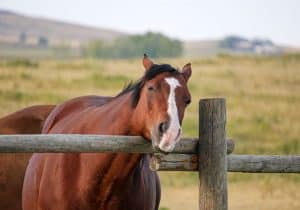Feeding Tevis Winners

Both riders know feeding their horses well is paramount to their success and long-term well-being. Carey Williams, PhD, equine extension specialist and professor at Rutgers University, in New Brunswick, New Jersey, who also has experience in feeding endurance horses, shared her advice with The Horse.
Endurance Feeding Program Overview
Williams said owners of endurance horses need to prioritize fat in their mounts’ nutritional programs. “It is best to have them on a high-fat, high-forage diet—high fat because this is the primary fuel source they use for endurance exercise. It helps sustain their energy for long periods of time during exercise.”
Schork said he feeds “a lot of beet pulp mixed together with rice bran, which adds fat.” He said he aims to have a high percentage of fat in the horses’ diets and minimizes starches and carbohydrates before a race. “We focus heavily on feed that is high in fat—between 12-20%.”
Blakeley said she keeps her horses’ feeding program as simple as possible. “We give free choice of hay (an orchardgrass mix), and (the horses have) access to our pasture,” she added. “When it is really cold in winter, we add alfalfa hay to their diet.”
Because most of her horses are easy keepers, Blakeley explained, she usually doesn’t need to add anything else to their diet to keep them at their ideal weight. She keeps an eye on their body condition when they are in heavy work to determine when they might need extra calories. “We also give them free choice of loose salt with selenium and loose minerals that are high in magnesium,” she said.
“I’m a strong believer in vitamin E, selenium, and zinc, together with some biotin and sulfur,” added Schork. “I’m also adding glucosamine (to promote healthy joints). A lot of times horses in heavy work can also benefit from additional magnesium (to aid in better hoof growth and quality).”
Vitamin E, explained Williams, can “help with muscle recovery and potentially help prevent tying-up (exertional rhabdomyolysis, which causes continuous, painful muscle contractions),” and she recommended adding it to endurance horses’ diets if they are not getting adequate amounts from their other feed sources, like pasture. “Oxidative stress can wear away at the muscle cell membranes, creating a ‘leaky cell’ where enzymes and other things could leak out and the cell could be destroyed.”
She added that in her research she’s found “high levels of vitamin E in the diet can decrease the muscle membrane permeability and decrease the risk of enzymes like creatine kinase and aspartate aminotransferase from leaking out of the cell and even possible clinical exertional rhabdomyolysis.”
Williams said water cannot be overlooked as a critical ingredient of endurance horse diets. “These horses right from the very start of their careers as endurance horses need to learn how to drink water,” she explained. “I know that sounds funny, but I am a dressage rider and eventer, and I see many horses that do not drink well during competition or traveling, and that is something that endurance horses really need to be able to do, not just before and after the race but anytime during the race.”
Drinking water “is important during vet checks, while crossing any streams, at the trailer, in the stall or pen,” she added. “Anytime they can get some water, it is important to allow them to drink because becoming dehydrated could end their race very quickly.”
A Forage- or Grain-Based Diet: What’s Best?
Williams recommends a “forage first” approach to feeding—a method Blakeley and Schork also employ.
When you start with a good-quality forage, said Williams, you can then “see what is leftover in the diet that can be provided by grain or supplements if necessary.
“Pasture is the best source of vitamins and will eliminate or at least limit the need for additional supplementation,” she continued. Owners of “highly competitive horses should have the forage in the pasture or hay tested to make sure there are not any mineral deficiencies that need to be addressed by additional supplementation.”
Schork said forage helps keep his horses’ stomachs healthy. “My forage is a mixture of alfalfa and grass,” he said. “I personally really prefer alfalfa. Sometimes grass hay alone doesn’t carry enough punch to keep the weight on the horses when they do 50- or 100-mile races. It doesn’t have the same calories as the alfalfa.”
Williams added that forage in the gut can also serve as a water reservoir during training and racing and help prevent dehydration.
Blakeley and Schork both feed concentrate to their horses that need it for the energy demands of work.
“We have some horses who are always on the lean side, especially Pyro,” says Blakeley.
Different Feed Plans for Different Endurance Horses
As they would with any other equine athlete, owners of endurance horses should base their feeding regimens on each individual horse.
“A 4-year-old might need an addition of a legume hay like alfalfa to add a little extra protein for growth,” said Williams, “and a retired horse can probably be just fine on forage and maybe a balancer pellet to make sure all the vitamins and mineral are in balance.”
Blakeley said she bases her horses’ diets on their body condition scores.
Schork does the same. “The horses who are hard keepers get more alfalfa than the easy keepers, which get more grass hay so they don’t get too heavy,” he said. “Retired horses get minimal grain. They just don’t need it anymore. It’s not just one size fits all.”
As for adjustments to feed regimens, he says a lot of information about what the horses need nutritionally can be gathered through observation. “I study a lot of the labels on the feed,” he said. “I watch the horses’ coats, their energy, how strong they are, to help me adapt their feed plans.”
Competition and Travel Essentials
“The critical supplement that all must have is an electrolyte,” said Williams. “And not all electrolytes are made equal. In order for them to be most effective … they must have salt (sodium chloride) as the first ingredient. If it is a sugar like sucrose or fructose it will not do much for replenishing the necessary electrolytes.
“Horses do not sweat like humans do,” she added. “Their sweat is highly concentrated, and just providing them a drink, like Gatorade, will not do the trick. It might taste good, but it is mostly sugar.”
Both riders incorporate electrolytes into their horses’ diets. Blakeley said she also offers soaked beet pulp to help keep horses hydrated without adding “heat.” She top-dresses these on the horses’ concentrates.
While Schork typically tries to limit his use of starches and carbohydrates, “once their system gets going during a race, and they are burning calories, we add more,” he said. “We add corn and higher-carb grains.”
When traveling with his horses, he said he adds a high-fat concentrate that includes a gastric-support supplement and soaked beet pulp to help with hydration.
Final Takeaways
Williams, Blakeley, and Schork each have their preferred methods and routines for keeping endurance mounts at the top of their game, but all keep the horses’ long-term health and comfort in mind.
“Endurance horses mainly need more calories,” emphasized Blakeley, to meet the demands of long rides.
Schork said his feeding strategy focuses on “healthy stomachs,” aiming to prevent problems such as gastric ulcers before they have a chance to occur.

Written by:
Shoshana Rudski
Related Articles
Stay on top of the most recent Horse Health news with















